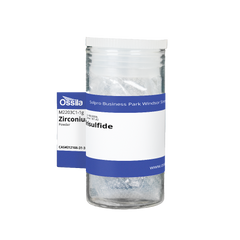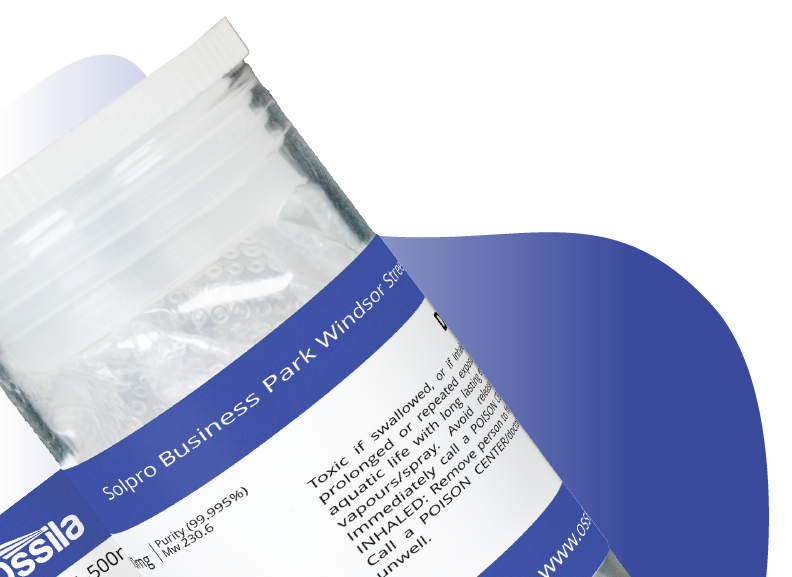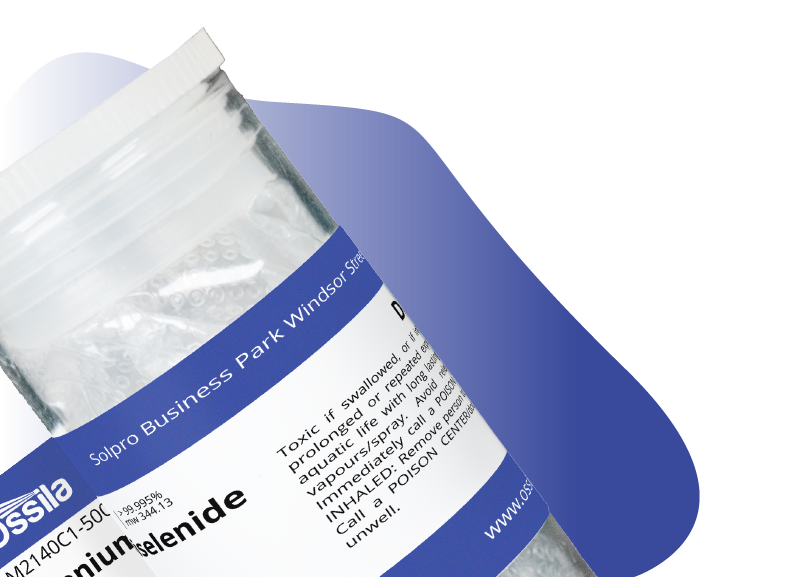Zirconium Trisulfide (ZrS3) Powder and Crystal
CAS Number 12166-31-3
2D Materials, Low Dimensional Materials, Materials, Transition Metal Chalcogenides (TMCs)
Please choose the appropriate MSDS from the list below. Links will open in a new window. If your browser does not support PDFs, you will be prompted to download the file instead.
Low price, high purity ZrS3 powder and crystals
For the development of perovskite devices, electronics and optoelectronics
Technical Data | MSDS | Literature and Reviews | Related Products
Zirconium trisulfide (ZrS3, CAS number 12166-31-3) is a typical representative of layered transition metal trichalcogenides (TMTCs).
ZrS3 is an indirect gap semiconductor as its bulk and its monolayer undergoes an indirect to direct band gap transition with increasing tensile strain. ZrS3 layers possess a pseudo one-dimensional nature where each layer consists of ZrS3 chains extending along the b-lattice direction. The optical properties of few-layer zirconium trisulfide has been demonstrated to be highly anisotropic as shown by large photoluminescence (PL) intensity variation with the polarization direction along the chain.
High Purity
>99.999% Zirconium Trisulfide Crystal Purity
Powder & Crystal
Different Forms of Zirconium Trisulfide
Low Cost
Low Cost Zirconium Trisulfide
Applications
Development of perovskite devices, electronics and optoelectronics
We supply zirconium trisulfide in both powdered and crystal forms.

Zirconium Trisulfide Powder
Can be used for preparation of zirconium trisulfide nanoplates and ultrathin films
Available in quantities of 1 g
≥99.995% purity
From £350

Zirconium Trisulfide Crystals by Size
Can be used to produce single or few-layer zirconium trisulfide sheets via mechanical or liquid exfoliation
Small (≥10 mm2) or medium (≥25 mm2) crystals available*
≥99.999% purity
From £520
*Typical representative size, areas/dimensions may vary.
Bulk single zirconium trisulfide crystals are most commonly used as sources from which single or few-layer sheets can be obtained via either mechanical or liquid exfoliation. Single zirconium trisulfide crystal or films produced from such crystals are suitable for study using atomic force microscopy or transmission electron microscopy
Platinum FET Test Chips for 2D Materials

- Affordable
- World-Wide Shipping
- Dual Channel Electrodes
Buy Online £200
Few-layer ZrS3 nanosheets and nanoparticles can also obtained from zirconium trisulfide powder by liquid-exfoliation.
Technical Data
| CAS Number | 12166-31-3 |
| Chemical Formula | ZrS3 |
| Molecular Weight | 187.42 g/mol |
| Bandgap | 1.90 eV [1] |
| Preparation | Synthetic - Chemical Vapour Transport (CVT) |
| Structure | Monoclinic |
| Electronic Properties | 2D semiconductor |
| Melting Point | 1020 °C (lit.) |
| Colour | Red brown |
| Synonyms | Zirconium trisulphide |
| Classification / Family | Transition metal trichalcogenides (TMTCs), 2D semiconductor materials, Nano-electronics, Nano-photonics, Photovoltaic, Materials science |
Product Details
| Form | Purity |
| Powder | ≥99.995% |
| Crystal | ≥99.999% |
Pricing Table
| Product Code | Form | Size/Weight* | Price |
| M2203C1 | Powder | 1 g | £350 |
| M2203A10 | Crystal | Small (≥10 mm2) | £520 ea. |
| M2203A25 | Crystal | Medium (≥25 mm2) | £850 ea. |
*typical representative size, areas/dimensions may vary
Shipping is free for qualifying orders.
MSDS Documents
Structure of Zirconium Trisulfide
Zirconium trisulfide (ZrS3) belongs to the low-symmetry crystals system with monoclinic structure. ZrS3 layers possess a pseudo one-dimensional nature where each layer consists of ZrS3 chains extending along the b-lattice direction.
ZrS3 may be better described by ionic model as Zr4+(S2)2-S2-. A basic structural fragment prism {ZrS6/2} is constructed from two disulfide (S‒S)2- groups as well as two sulfide groups S2- with Zr atom situated near the centre of the prism. Such prisms with metal atoms situated close to the prism centres are connected to each other via common triangle bases to form infinite columns. This leads to strong anisotropic behaviour that offers additional advantages over isotropic 2D systems.

Literature and Reviews
- Single layer of MX3 (M=Ti, Zr; X=S, Se, Te): a new platform for nano-electronics and optics, Y. Jin et al., Phys. Chem. Chem. Phys., 17, 18665-18669 (2015); DOI: 10.1039/C5CP02813B.
- Strong dichroic emission in the pseudo one dimensional material ZrS3, A. Pant et al., Nanoscale, 8, 16259 (2016); DOI: 10.1039/c6nr05238j.
- Angle resolved vibrational properties of anisotropic transition metal trichalcogenide nanosheets, W. Kong et al., Nanoscale, 9, 4175 (2017); DOI: 10.1039/c7nr00711f.
Related Products
We stock a wide range of 2D materials available to purchase online. Please contact us if you cannot find what you are looking for.

 Zirconium trisulfide powder
Zirconium trisulfide powder

